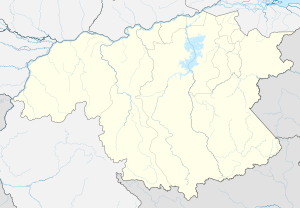Bridge over the Río Caroní
Coordinates: 8 ° 19 ′ 22 " N , 62 ° 41 ′ 30" W.
| Bridge over the Río Caroní | ||
|---|---|---|
| First and second bridges over the Caroní River | ||
| use | Road bridge | |
| Crossing of | Río Caroní | |
| place | Ciudad Guayana | |
| construction | Prestressed concrete bridge | |
| overall length | 480 m | |
| width | 10.30 m | |
| Number of openings | five | |
| Pillar spacing | 96 m | |
| start of building | 1962 | |
| completion | 1964 | |
| planner | Fritz Leonhardt | |
| location | ||
|
|
||
The bridge over the Caroni ( Spanish Puente sobre el Caroni ), in the technical literature as Caronibrücke or Caroni bridge referred to was the first bridge over the Caroni in Venezuela .
location
The bridge over the Río Caroní stands 4 km above its confluence with the Orinoco in Ciudad Guayana , a city in the state of Bolívar that was officially founded in 1961 , and connects the old town of San Félix with the new industrial district of Puerto Ordaz .
The Río Caroní is only 450 m wide at the location of the bridge . With an average water flow it is 21 m deep; the flow speed reaches 5 m / s (18 km / h). It can rise 12 m in 36 hours. The use of falsework was therefore not possible. Its subsoil consists of a 2 to 6 m thick layer of rubble over solid granite . However, there is an approximately 90 m wide fault crevice of unknown depth, on which no pillars could stand, and which thus dictated the span of the bridge.
description
The bridge is known worldwide in specialist circles as the first bridge to be built using incremental launching .
It was designed by Fritz Leonhardt from January 1962 to May 1964 by a group from the Venezuelan company Telven and the German construction companies Ed. Züblin and Baresel built. Subsequently, Fritz Leonhardt and Willi Baur developed the incremental launching process used worldwide today.
The bridge is 480 m long (between the abutments ). Their field widths are 48 + 96 + 96 + 96 + 96 + 48 m. Its width of 10.30 m is divided into an 8.50 m wide carriageway with two lanes and a 0.60 m wide edge strip and 0.30 m wide parapets. Pedestrians have two separate, 3 m wide paths, which are mounted below the road on both sides of the base plate of the hollow box and are thus protected from traffic, sun and rain. In the abutments there is a cross connection between the sidewalks.
The carriageway girder consists of a continuous , single-cell prestressed concrete box with a constant cross-section. The carriageway slab protruding 2.40 m on both sides is also the cover slab of the box girder, which is 5.40 m high and has a 4.00 m wide base slab and slightly sloping side walls.
The 22 m high reinforced concrete pillars have a variable hollow cross-section and stand on concrete foundations several meters high, which are anchored with tensioning anchors in the rock below. Their cavity only dries out at low tide, otherwise it is connected to the water level of the river through openings.
The carriageway girder was built entirely on land, divided into 50 prefabricated parts each 9.20 m long with a joint width of 40 cm, which were all concreted in the same formwork. An auxiliary pillar made of concrete was built in each of the large openings, so that a total of 10 openings of 48 m each resulted. The middle tense and with a launching nose provided road carrier was then - pushed as a whole over the river - on neoprene pot bearings with Teflon sliding layer. A feed rate of 6 cm / minute was achieved. The tensioning cables were then brought into their final position and coated with concrete to protect against corrosion. The sidewalks and their parapets, also manufactured as prefabricated parts, were assembled with tendons.
The original plan was to build a second, identical bridge next to it for oncoming traffic. In fact, it was not until 1978 that this second bridge, now with three lanes, was opened to traffic. In the meantime there is a third bridge, which was built in connection with the Macagua Dam , which is a little upstream , as well as a fourth, the combined motorway and railway bridge Puente Angosturita, directly in front of the mouth.
Web links
- Caroni Bridge. In: Structurae
- Alavaro Fernandez: Puente de hormigón pretensado sobre el río Caroní
Individual evidence
- ↑ The information in this article is based, unless otherwise noted, on the essay by Fritz Leonhardt, Willi Baur: Bridge over the Rio Caroni, Venezuela. In: Beton- und Stahlbetonbau , Volume 61, Issue 2, February 1966, pp. 25–38

